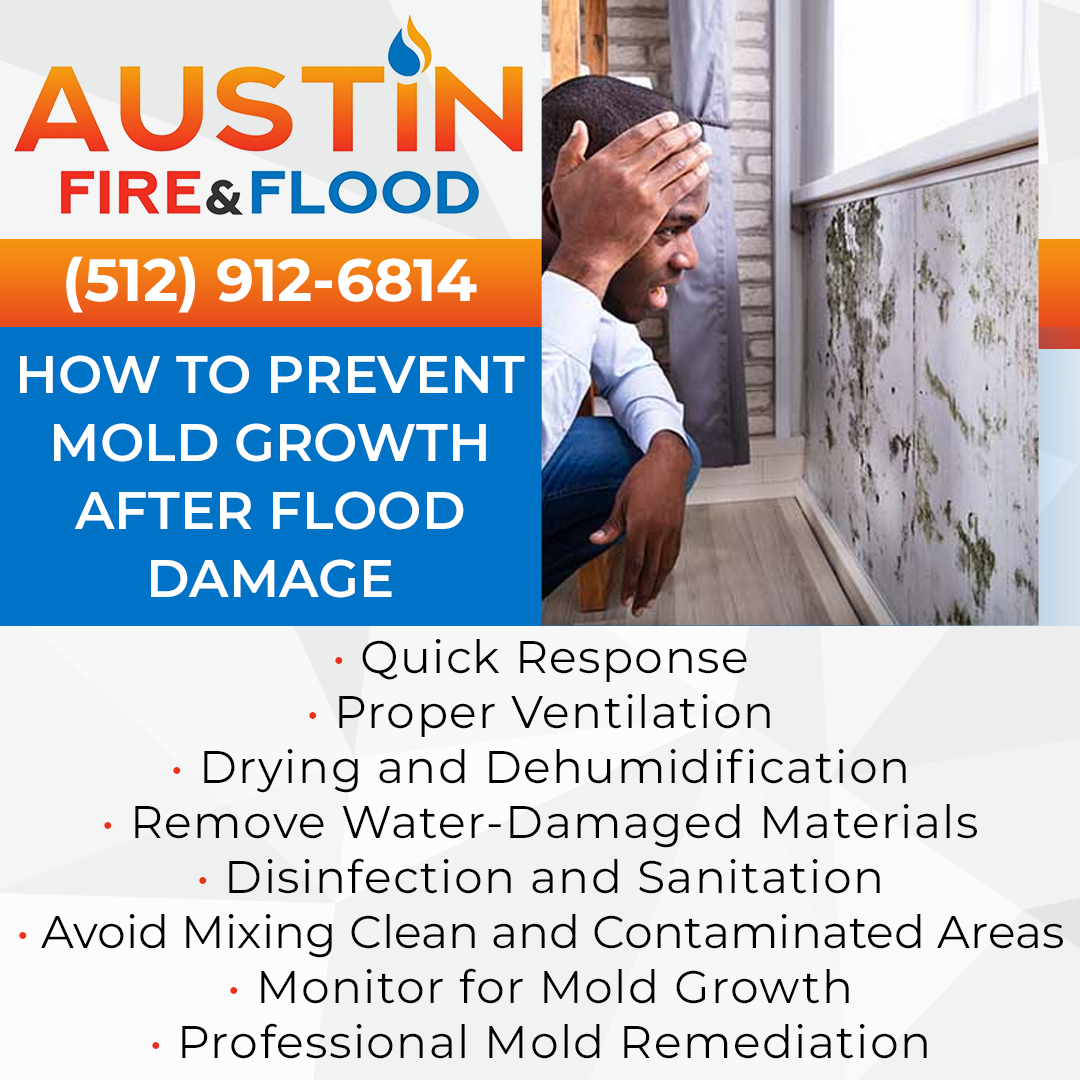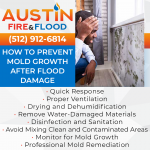When flood damage occurs, the aftermath can be overwhelming. You must deal with water damage, the loss of personal belongings, and the possibility of mold growth. Mold growth can harm your health, causing allergies, respiratory issues, and other health problems. Taking action immediately after a flood is essential to prevent mold.
Austin Fire and Flood is a fully bonded, licensed, restoration contractor in Austin. They provide emergency services like flood damage restoration in Windsor Hills, Austin, TX, and neighboring areas. Their technicians quickly reach the flooding site and provide a thorough evaluation, estimate, and water damage restoration plan. Experts at Austin Fire and Flood discuss preventing mold growth after flood damage to keep your home healthy and safe.
.png)
Quick Response is Key
Quick response is key to preventing mold growth after flood damage. The longer the floodwater is left standing, the more likely mold will begin to grow. Prompt response within the first 24-48 hours is critical to preventing mold from taking hold. The first step is to call a professional flood damage restoration company to assess the damage and start the cleanup process. The company will have the necessary equipment to remove excess water and moisture from the affected areas, such as pumps and dehumidifiers. The quicker the water is removed, the less damage and fewer opportunities for mold growth. Hence, the importance of quick response cannot be overstated in minimizing mold growth after flood damage.
Proper Ventilation
When the air circulates and is properly ventilated, it dries out wet surfaces and discourages mold growth. This can be achieved by opening windows and doors and using fans or air conditioners to promote air circulation. Cross-ventilation is also important to ensure that air moves freely, preventing stagnant air in areas where moisture may have accumulated. When humidity is high, a dehumidifier can also remove excess moisture from the air.
Drying and Dehumidification
This step should be done after removing any water-damaged materials. Proper ventilation during the drying process is also key. If the weather permits, opening windows and using fans can promote air circulation and speed up drying. If the humidity level is high, a dehumidifier can decrease the moisture in the air. It is important to monitor the drying process and keep the area well-ventilated until all moisture has been removed. Failure to properly dry the area can result in mold growth, which can cause health problems and further damage.
Remove Water-Damaged Materials
Carpets, drywall, insulation, and even furniture can all become breeding grounds for mold if they are not properly dried or removed. This is difficult, but it is necessary to prevent the spread of mold throughout your home. It's important to wear protective gear while removing these materials, as they may contain harmful substances like bacteria or chemicals. Once these materials have been removed, it's crucial to dispose of them according to local regulations.
Disinfection and Sanitation
Disinfecting and sanitizing are crucial steps in preventing mold growth. After removing any water-damaged materials, the affected area should be thoroughly cleaned with a disinfectant to kill mold and other harmful bacteria. It is important to remember that even clean-looking surfaces can harbor mold spores, so proper sanitization is key.
Avoid Mixing Clean and Contaminated Areas
Cross-contamination can occur via foot traffic, air movement, or shared equipment in affected areas. To prevent this, designate areas as "clean" or "contaminated" and use physical barriers such as plastic sheeting or tape to cordon off impacted areas. If possible, maintain negative air pressure in contaminated areas to prevent contamination from circulating to other parts of the building. Proper cleaning and disinfection techniques should be used on all equipment and tools used in contaminated areas before removing the barriers.
Monitor for Mold Growth
Regular inspections will allow for early detection of recurring mold and prompt action. Some signs to look out for include musty odors, visible mold growth, and discolored walls or ceilings. If any of these signs are observed, it is important to take immediate action and contact a mold remediation professional to assess the extent of the damage and provide the necessary solutions. It is important to continue implementing preventive measures to keep the affected area mold-free.
Professional Mold Remediation
Sometimes, it may be impossible to avoid mold growth after flood damage. If so, it is best to hire a professional mold remediation service. Working with a professional mold remediation service ensures that the mold problem is handled safely and effectively and that the affected property is restored to its pre-damage state. They use specialized equipment and expertise and follow strict protocols that do not risk spreading the spores to unaffected areas.
Professional mold remediation uses techniques like HEPA air filtration systems, negative air pressure machines, and dry ice blasting to remove and dispose of mold-contaminated materials without causing further damage or health hazards. They also use specialized cleaning solutions to disinfect the affected areas to prevent any future mold growth.
.png)
Austin Fire and Flood is the best fire and water restoration company and offers flood damage restoration services in Austin, TX. The highly trained and certified technicians at this company are committed to restoring your property to a pre-flood condition so that the disruption to normal life is minimal. Call Austin Fire and Flood for emergency flood damage restoration in Windsor Hills, Austin, TX, at (512) 912-6814.






























